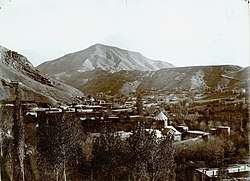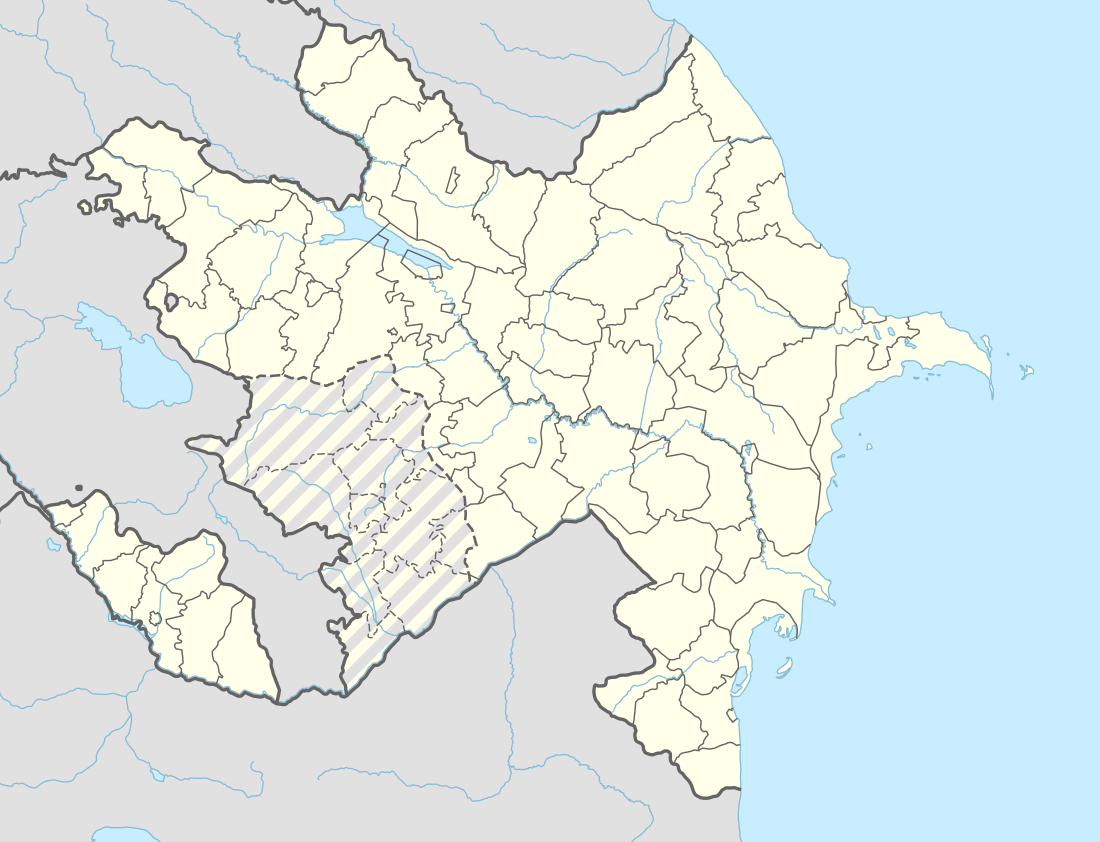Yuxarı Əylis
Yuxarı Əylis (Armenian: Վերին Ագուլիս, Verin Agulis, both meaning "Upper Agulis/Əylis")[1] is a village and municipality in the Ordubad Rayon of Nakhchivan, Azerbaijan. It is located in the left and right sides of the Ordubad-Aylis highway, 12 km in the north-east from the district center. Its population is busy with gardening, farming, animal husbandry. There are secondary school, club, library, communication branch and a medical center in the village. It has a population of 1,916.[2] The village was an important settlement of the Vaspurakan province of the Kingdom of Armenia or the Vaspurakan Kingdom, and many world-known Armenian merchants instrumental in Silk Road were of Agulis origin, which demonstrates the importance that the city has had in Armenian History.
Yuxarı Əylis | |
|---|---|
Municipality | |
 City panorama in early 1900s | |
 Yuxarı Əylis | |
| Coordinates: 38°57′10″N 45°58′53″E | |
| Country | |
| Autonomous republic | Nakhchivan |
| Rayon | Ordubad |
| Population (2005) | |
| • Total | 1,916 |
| Time zone | UTC+4 (AZT) |
| • Summer (DST) | UTC+5 (AZT) |
History
Yuxarı Aylis was first mentioned in historical sources in the 11th century under the Armenian name "Argulik.'" Its Armenian population specialized in the production of handicraft and sericulture. Numerous sixteenth-century sources spoke of it as a thriving town that maintained strong commercial links with India, Russia, Safavid Persia and Western Europe.[3]
In the 18th century, Agulis had its own schools, a library, a silkworm factory, a large market. The town was enclosed by walls and surrounded by orchards and vineyards. Its Armenian population at the time was recorded at 8,000 households.[3] In 1752, it was captured and subjected to a heavy sack by the armies of Azat Khan, the ruler of Āzarbāijān.[3] The town was incorporated into the Russian Empire in 1828, following the Russo-Persian War. By 1897, when a census was carried out by the Russian government, Agulis' population had dropped to 1,670.
In the nineteenth century, Verin ("Upper") Agulis, together with the adjoining Nerkin ("Lower") Agulis, was a major Armenian settlement in the Nakhichevan uyezd of the Erivan Governorate, with twelve churches and monasteries. The most important church was the St. Thomas the Apostle Monastery, whose date has not been recorded, although inscriptions mention that it was restored in 1694.[3] The monastery was an important center of learning, producing such luminaries as the merchant and traveler Zak'aria Aguletsi, A. Araskhanyan, animal breeder Avetis H. K'alant'ar, and L. Manvelyan.[3] The community also spoke in an especially unique dialect of Armenian called Zok.[4]
Destruction
In the spring of 1919, the First Republic of Armenia extended administrative control over the region of Sharur-Nakhichevan, with Agulis being made the center for the subregion of Goghtan. But in the summer of the year, a Muslim insurgency broke out against Armenian rule, and in August the region came under the control of the newly appointed commissar of Ordubad, Abbas Guli Bey Tairov.[5] Agulis pledged its loyalty to Tairov, although in the following months, its inhabitants faced a growing food crisis and were not allowed to leave the town. The plight of its inhabitants worsened when, in November of that year, the Azerbaijan Democratic Republic unsuccessfully attempted to wrest the region of Zangezur from Armenian control.[6]
Matters came to a head on December 17, when a frenzied Muslim mob, made up of locals and refugees fleeing from the fighting in Zangezur, made its way to Lower Agulis and began to attack its Armenian inhabitants, forcing them to retreat to the upper town.[7] On December 24, the mob, joined by the local Azerbaijani gendarmerie, entered Upper Agulis and started to pillage the town. They then proceeded to massacre its Armenian population, leaving Upper Agulis in smoldering ruins the next day. According to the Armenian government, up to 400 Armenians were killed in Lower Agulis and up to 1,000 in Upper Agulis.[8] The town was partially rebuilt during the Soviet period.
Monuments
The Saint Thomas monastery was, according to the legend, founded by Bartholomew the Apostle. It was last restored in 1694[3]. It was destroyed at the end of the 1990s. A mosque was built on its former emplacement.
Cultural references
The 1919 destruction of Agulis is referred to in the controversial 2012 novella Stone Dreams by Azerbaijani writer Akram Aylisli.[9]
Notable natives
- Ziya Kyazim — Azerbaijani Soviet actor, People's Artist of Azerbaijan SSR (1943)[10]
- Akram Aylisli - Azerbaijani writer
- Mouchegh and Melkoum Petrossian - Founders of Caviar Petrossian in Paris, France.
Notes
- also spelled Yukhary Aylis, Aqulus, Akulus and Akulis
- ANAS, Azerbaijan National Academy of Sciences (2005). Nakhchivan Encyclopedia. volume II. Baku: ANAS. p. 357. ISBN 5-8066-1468-9.
- (in Armenian) Barkhudaryan, Sedrak. «Ագուլիս» [Agulis]. Armenian Soviet Encyclopedia. Yerevan: Armenian Academy of Sciences, 1974, vol. 1, p. 61.
- See Bert Vaux, "Zok: The Armenian Dialect of Agulis," in Between Paris and Fresno: Armenian Studies in Honor of Dickran Kouymjian, ed. Barlow Der Mugrdechian. Costa Mesa, CA: Mazda Publishers, 2008, pp. 283-302.
- Hovannisian, Richard G. (1982). The Republic of Armenia, Vol. II: From Versailles to London, 1919-1920. Berkeley: University of California Press. p. 234. ISBN 0-520-04186-0.
- Hovannisian. Republic of Armenia, pp. 207-234.
- Hovannisian. Republic of Armenia, p. 235.
- Hovannisian. Republic of Armenia, pp. 236-238.
- Mkrtchyan, Gayane (18 April 2013). "Matter of Copyright: Armenian publishers of novel by Azeri writer ready to pay compensation upon request". ArmeniaNow.
- Кязим Зия (in Russian). Great Soviet Encyclopedia.
Further reading
- (in Armenian) Alishan, Ghevond. Սիսական [Sisakan]. Venice: Mkhitarian Press, 1893.
- Ep'rikean, S. Պատկերազարդ բնաշխարիկ բառարան [Illustrated geographic dictionary], vol. 1. Venice: Saint Lazarus, 1902, pp. 4–15.
- Zak'aria of Agulis. The Journal of Zak'aria of Agulis. Armenian Studies Series, No. 4. Trans. George Bournoutian. Costa Mesa, CA: Mazda Publishers, 2002. ISBN 1-56859-107-1.
.svg.png)